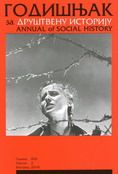Američka, britanska, sovjetska i nemačka filmska vizija Balkana u ratno doba
View of the war-time Balkans in the American, British, Soviet and German films
Author(s): Aleksej J. TimofejevSubject(s): Theatre, Dance, Performing Arts
Published by: Udruženje za društvenu istoriju
Keywords: World War II; film; cliches; war-time propaganda
Summary/Abstract: Role of Tito, as a leader of a member of anti-fascist coalition in the World War II was unavoidable in artistic and scientific cliches used in socialist Yugoslavija. Yowever, history of modeling of “Balkan hero” originates from the war-time propaganda production. A part from such propaganda – a film view of Yugoslavs – could be seen in American, British, German and two shorter Soviet films, which were filmed during the war (1941–1943.): „Chetniks! – The Fighting Guerrillas“ (USA – 1942), „Undercover“ (Great Britain – 1943), „Yundred for one”(„Сто за одного“) (СССР - 1941), „Night over Belgrade” („НочY над Белградом“) (СССР - 1942), „Men in the Attack” („Menschen im Sturm“) (Germany – 1941). In autumn 1941. Draža Mihailović and his movement were the only antifascist movement in the occupied Europe, known to the wider public in Great Britain and the USA, not Tito and partisans. The uprising in the rear of the hated enemy had to be shown using the stereotypical cliches of „Sherwood forest hero” or „Wild west cowboy”. On the other hand, Sovet propaganda also needed a story about active guerilla war in the enemy’s rear. Along with the theme of „national resistance to the German occupator”, very attractive were the films about uprising of the peoples of the occupied Europe against the fascists. Anti-thesis of these films shot in the countries of anti-fascist coalition is a feature film dedicated to the other side of propaganda cliche about violent mentality of Yugoslavs and Serbs. The period when American, English, Soviet and German war films were publicaly available was very short. Yowever, widely accepted stereotype about Western Balkan as a «barrel of gunpowder», got very strong support in these films. This stereotype has been revitalized again by the end of 20th century, after the break of Tito’s Yugoslavia.
Journal: Godišnjak za društvenu istoriju
- Issue Year: XVII/2010
- Issue No: 2
- Page Range: 39-48
- Page Count: 10
- Language: Serbian

